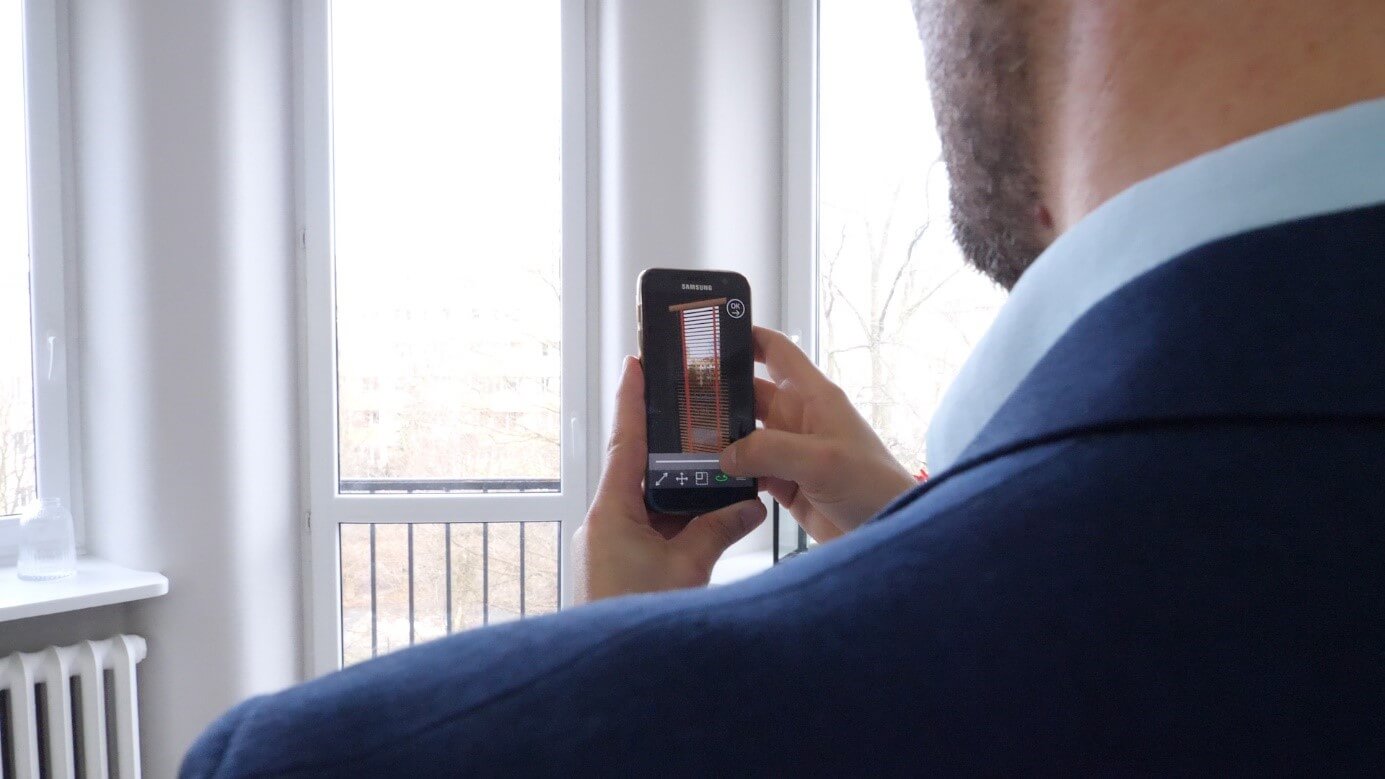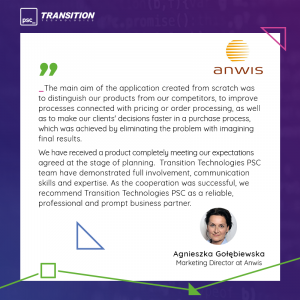_An effective way to utilize Augmented Reality (AR) for arrangement of window blinds with ability to estimate their sizes
Industry
Manufacturing
Challenge
- Designing an intuitive user interface
- Time-consuming and costly processes
- Effective integration of AR technology
Technologies
AR, Android
Results
- Developing a mobile AR app MVP for Android

ANWIS Wloclawek, Poland
The owner of one of leading European brands – ANWIS – specializing in manufacturing window blinds and components used for their production is Anwis Sp.z.o.o., which has been operating in the market since 1979. In their offer, you can find a dozen or so product groups of window blinds in outdoor and indoor systems, including: roll up, pleated, vertical and horizontal ones. ANWIS pays special attention to elements such as: design, functionality, quality (products are created with the use of the newest materials), as well as making products customized to individual orders. Moreover, as a company, they offer a wide range of details made from aluminum, plastics, wood, or steel.
For nearly forty years of being in the market, ANWIS has worked out a leader’s position in the field of window blinds. It has around 1000 distributors in Poland, sells to 42 countries, and produces around 3000 pieces of their products daily.
Needs and challenges
Anwis has established its strong position in the market and it’s connected with technological advantage in the form of shortening the access channel to given products – which is of great value for the company itself. Agnieszka Gołębiewska – Marketing Director at Anwis – has turned to Transition Technologies PSC with the idea of using Augmented Reality technology. The main goal was to make it easier to visualize the company’s products in given interiors with the use of a mobile phone.
Anwis Home application uses augmented reality which makes it possible to match window blinds to particular interior easily. Available for mobile devices, it is a useful tool which, using a built-in camera, combines the real view with the virtual one. It can reflect the real look of 3D products, including size and the scanned surrounding’s plane. This way, we will place a virtual product in a window and check of a chosen blind matches a particular room.
Those are solutions expected from an app which will become a handy tool for clients who use smartphones or tablets on a daily basis. Installed in a device, it will simplify and accelerate the process of choosing the right window blind. The software will also allow clients to see the whole range of products by Anwis. In the world where we like making decisions concerning details as well as we expect greater and greater functionality of provided solutions, Anwis Home enables full customization of a product and fitting it into any room where we currently are. We would like Anwis Home to be an app which is not only addressed to direct users, but also to our trading partners as well as designers and interior decorators. An important aspect for us is a possibility of developing the app. In the future, we would like to expand Anwis Home with a possibility of combining it with sales network, where a Client, apart from choosing a product, can buy it, or use a communication channel which will make it possible to contact a professional assistant. – says Agnieszka Gołębiewska, Marketing Director of Anwis Sp. z o.o.
The needs, which we got signaled, meant promoting the company with the use of advanced digital technologies. What is more, an important element was also entering the virtual and Augmented Reality world for a better product visualization in their destination, but not only.
It’s worth highlighting that the provider does not have ready-made window blinds with them, but only color samples and small demonstration display showing how their mechanism works and some details.
Currently, final customers have the access to Anwis products only by means of traditional channels, which means distributors. They order measuring the blinds by phone or by an online form, and next, it continues with an individual visit of a distributor/representative in a place where it should be installed (house, flat, office), which is time-consuming and very expensive. It is the cost of a provider and it significantly influences the final price of a product.

Because of developing the app with the use of Augmented Reality, we have influenced the increase of attractiveness of a product choice with a wow! Effect, which was caused by easiness of demonstrating the future look of window blinds in their destination, without having to imagine them, comparing samples, displays, etc. It also results in faster client’s initial decision as for the purchase – even without a distributor. It also influences the possibility of estimating the size and width of blinds, which influences the final cost of product.
Therefore, access to application for a wider group of users builds the advantage of: reaching a greater number of distributors and final customers, reducing the cost of individual trips in order to make measurements and pricing.
Obviously, a great challenge for TT PSC programmers was the right choice of technology which could allow to provide the bigger number of functionalities in the app. Moreover, an important factor was being user-friendly which means transparent UI and intuitive operation. The application was supposed to be static in terms of data feeds, without a possibility of editing defined information. We received a demonstrative model of a typical window blind in a window frame and color pattern, in order to make an attempt to copy characteristic features, blinds movement specifics and colors.

Among potential barriers in functionality, it was important to identify precisely the plain of a real object, which often means a poorly-lighted wall being in contrast with a bright window aperture and to embed a chosen virtual item (wooden blind 50mm) in the place steadily. The blind in the form of 3D object had to resemble the real one as much as possible.
Another challenge was a maximum number of available smartphone models, which would be able to use the Augmented Reality functionality.
Implemented Solution
Developers team consisting of Michał Neufeld and Grzegorz Kiernozek started developing MVP mobile application dedicated to smartphones with Android. On the basis of prepared main assumptions, being driven by optimal choice of available functionalities and stability of the AR software, they chose environment based on framework for Unity app developing, as well as framework supporting Augmented Reality ARCore. At the first stage, one operating system has been chosen – Android. Next, based on developers.google.com, a list of smartphone models supporting ARCore technology has been defined.
How the application works. A user chooses physical places for the future installation of Anwis products (for example, wooden window blind 50mm) and starts the app. In the first step, you need to scan the real object from different angles (window recess, window, etc.). Owing to this activity, we make it possible for ARCore engine to identify characteristic points of the plain, where – in the next step- base window blind hologram will be embedded.
The imposed 3D view of the blinds can be fully navigated, which means that it can be moved, rotated and scaled. A user can do the activities being at the same screen thanks to defined buttons and icons, until they are sure that the blinds has been fitted perfectly as for its position and size against the scanned window opening.

The next step is moving to the screen which improves the visual experience, which is the choice of bar and case colors, as well as, individually, conductive ribbons. The determination of physical dimensions of the blinds is achieved by making a photo of the object. Then, the numbers which mean the length and width of the blinds appear in the name of a file.
The application in the testing phase was placed in Google Play testing platform. It is possible to provide the app in a form of a package for Android to any distribution by Anwis.
The results and functionalities
The application uses Augmented Reality mechanism and makes it possible to visualize products by Anwis in a real destination spaces. In other words, the digital 3D product model (e.g. window blinds) is imposed on the view from a smartphone camera and can be embedded in a real window opening. Thus, a client can check how Anwis products look in their rooms.
The product is presented in the form of an animated 3D model and enables an option of scaling to the size of a particular window dynamically. It’s worth paying attention to the animation layer in the app. The simulation of lifting and releasing blinds as well as rotating ribbons up and down shows how the effect of covering window openings works from a perspective of a person looking from different angles. After making a choice, the client has a possibility of going to the website by Anwis and sending photos of a chosen product – being able to use any electronic communication channel.

Further app development plans
The original version of the app assumes its further development and expanding it with additional functionalities. On the base of interviews with users, there has been prepared a list of functionalities being introduced which can turn the app in MVP version into a completely operational mobile sales and marketing tool.
Propositions of developing the app is also a possibility of visualizing the rest of Anwis products, i.a. roller blinds, gathers, Venetial blinds, and what is more, compatibility of the app with iOS.
Transition Technologies PSC is going to take part in marketing and educational campaign connected with the app’s promotion inside the company as well as for its clients. As its part, it has been offered:
– creating a promotional or training video, posters, imprints, banner displays, etc.
– social network promotion,
– running a training or taking part in training crucial users.

Let’s get in touch
Contact us